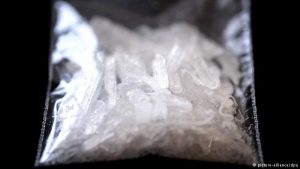 Methamphetamine is a highly addictive synthetic stimulant that affects the central nervous system. It comes in clear chunky crystals resembling ice and is most commonly smoked. It can also be snorted, injected or swallowed.
Methamphetamine is a highly addictive synthetic stimulant that affects the central nervous system. It comes in clear chunky crystals resembling ice and is most commonly smoked. It can also be snorted, injected or swallowed.
Methamphetamine is also referred to as Beannies, Brown, Chalk, Crank, Chicken feed, Cinnamon, Crink, Crypto, Fast, Getgo, Methlies Quik, Mexican crack, Pervitin (Czech Republic), Redneck cocaine, Speed, Tick tick, Tweak, Wash, Yaba (Southeast Asia), Yellow powder, Fire, Tina, Poor man’s cocaine, Uppers, Trash, Yellow bam, Stove top, Go Fast, Batu, Blade, Cristy, Crystal, Crystal glass, Glass, Hot ice, Ice, and Quartz.
Methamphetamine usually comes in the form of a crystalline white powder that is odorless, bitter-tasting and dissolves easily in water or alcohol. Other colors of powder have been observed, including brown, yellow-gray, orange and even pink. It can also be compressed into pill form.
Methamphetamine is an illegal drug in the same class as cocaine and other powerful street drugs. It has many nicknames—meth, crank, chalk or speed being the most common. Below are warning signs to look for if you suspect someone who is using Methamphetamine.
Physical Warning Signs of Crystal Meth Abuse
Dilated Pupils
Dilated pupils are one of the meth addiction symptoms that an addict can experience for about 26 hours after they take the drug. Bloodshot eyes are another; most addicts will want to wear sunglasses to hide their eyes from others while they are dilated.
Weight loss – Not eating for several days, loss of appetite
Eating disorders often result from methamphetamine use, extreme weight loss, appearing bony and gaunt is one of the most common symptoms; users will have no appetite. It is common to see a large weight loss in a very short amount of time when a person is addicted to methamphetamine.
Eye Twitching – Uncontrolled twitching or jerking, such as eye twitching
Methamphetamine users can experience different body reactions to meth. One of the most common body reactions is eye twitching. Their eyes will twitch several times every minute and this is something that won’t be able to control until they have completely detoxed off of the drug.
Chronic nasal problems – i.e. deviated septum, nosebleeds
Methamphetamine can be used in a variety of ways, but snorting is common among those who are afraid of needles. Snorting methamphetamine can cause damage to the nose and sinus cavities. Bleeding from the nose is common, as are sinus infections and pressure. Some users have reported damage to the lining and cartilage of the nose. In extreme cases, it can cause a hole in your nose.
Body Odor – Excessive Sweating
Methamphetamine users will have a harsh smell to them and they will often sweat a lot. This odor will remind you of cat urine. Meth labs often have this same smell. The chemicals in the drug are what can cause the person to have this smell to them when they sweat and it comes out of their pores.
Itchy Skin – Skin sores, abscesses or lesions from scratching or picking at face and skin
Methamphetamine users will have very dry, itchy and cracked skin, especially around the lips and fingertips. Track marks may be present in those who use crystal meth in its injectable form. Another trademark sign of meth abuse is the presence of “meth mites,” in a phenomenon known as “formication,” where users experience the sensation of insects crawling on or underneath the skin. The resulting itching and picking lead to infected, open sores that often scar. Acne and rashes also often result from poor hygiene, dehydration and poor diet. Skin around the nails is often infected, as well, due to compulsive nail biting.
Meth Mouth – Rotting teeth/tooth loss
One of the telltale signs of methamphetamine use is “meth mouth” – a host of tooth decay and gum disease caused by chronic meth use. Methamphetamine has an incredibly drying effect on the mouth, leading to clinical cases of dry mouth, promoting tooth decay and often leading to tooth loss. Mouth sores result from dehydration and lack of oral hygiene, and tooth grinding often leads to worn teeth and receding gums. This will lead to more weight loss, since it will be much harder and painful for them to eat or drink anything. Because methamphetamine use often leads to carbohydrate and sugar cravings, cavities often also abound in meth users. Heightened adrenaline levels also lead to jaw clenching, further wearing down teeth and gums.
Burn marks on fingers or mouth (from smoking meth)
When smoking methamphetamine through a hot glass or metal pipe, users will have strange burns on lips or fingers.
Behavior Warnings Signs of Crystal Meth Abuse
Excessive talking, rambling
Along with the fidgety behavior, one is uncharacteristically talkative, to the point that they may be incoherently rambling. If a person suddenly seems hyperactive and obsessive, it may be an indication they are using methamphetamine.
Insomnia, not sleeping for extended periods
Staying awake for days, and/or not getting enough sleep; as with anyone who doesn’t sleep, dark circles or “bags” under the eyes will persist, giving the appearance of eyes being “sunk”. Typically, any and all effects on the eyes are a result of sleep deprivation.
Sleeping for several days
When methamphetamine users stop using the drug, they are in for the week of sleeping, lethargy and only being able to wake up (barely) to go to the bathroom and eat some food. The meth comedown is not as dangerous as say, a heroin withdrawal, but it is still uncomfortable and detrimental, and causes many users to continue using in fear of going through this withdrawal.
Not eating for several days, loss of appetite
Malnutrition is common in methamphetamine users as they tend to avoid food while high and may not eat a proper diet or receive adequate nutrition when they are sober or between “highs.”
Repetitious Behavior – Compulsive Actions, Fidgeting, unable to sit still
Due to the excess adrenaline produced by crystal meth, many individuals experience repetitive motions/behaviors. Users may experience involuntary muscle movements, muscle twitches or handwringing as their bodies respond to excess energy. They will often want to take things apart and put them back together, exercise excessively or find other repetitive projects to do. They will not be aware of their surrounding when they have dealing with these behaviors.
Hyperactivity – Nervous or Anxious
Hyperactivity can be a symptom that can be hard to detect if the person was very hyperactive before they started using the drug. When a meth addict gets their high they may become very hyper and can’t stop moving. They can become very dangerous to people around them or to themselves.
Short term memory loss
Methamphetamine users may suffer brain damage, including memory loss and an increasing inability to grasp abstract thoughts. Those who recover are usually subject to memory gaps and extreme mood swings.
Hallucinations
Auditory is the false perception of sound and the most frequent type of hallucination. Most frequently the user “hears voices.” Command hallucinations are “voices” that may issue commands for violence to others. Another is visual where the user sees a person, object or animal that does not exist in the environment. For example, a user sees a lion coming toward him. Olfactory is the false perception of smelling odors that are not present in the environment. For example, a user smells his “brain rotting.” Tactile is a false perception of the sense of touch, often of something on or under the skin. Gustatory is the false perception of the sense of taste. For example, a user refuses to eat because he tastes poison in his food.
Paranoid – Psychosis and Paranoia
Often when a person is a meth addict, they will become very paranoid for no reason. They will think everyone is out to get them. They will become very sheltered and not want to go out in public. They will often keep to themselves and go long periods of time before they want to communicate with anyone else.
Aggressive behavior
Crystal meth notoriously inflates self-perception. Many users experience a lack of shyness, increase in assertiveness, heightened aggression, inflated egos and even delusions of magnificence. Periods of rage may also occur with crystal meth addiction.
Mood Changes – Mood instability
While there are many different psychological disorders that can cause mood changes, methamphetamine users will also experience them. High doses of meth can cause permanent depression for some addicts. Many individuals addicted to methamphetamine develop a “flat affect” or emotional numbness and lack of response. Depression is common, particularly during the “crash” phase that follows use, and users often feel emotionally depressed for up to a year after recovery.
Delusions
Methamphetamine users feel threatened and believe that others such as law enforcement intend to harm them in some way. The user thinks that unrelated events or happenings are somehow connected to him or her, usually in a negative way. For example, a user watching TV thinks the news broadcaster is trying to get a message to him.
Suicidal thoughts
Research has found that for those who use methamphetamine, the risk of attempting suicide is significantly higher than for users of other types of injected drugs. The researchers discovered that methamphetamine users are 80 percent more likely to attempt suicide than those who inject other substances.
Indirect Signs of Methamphetamine Use
Missing or stolen money or valuables or frequent requests to borrow money, particularly with nothing to show for it
Aluminum foil with burn marks (if smoking)
Straws (used to snort), especially with burn marks (used to smoke)
Empty plastic pen cases (used for snorting or smoking)
Small plastic bags
Water pipes or other pipes (used to smoke)
Rolled up dollar bills or paper (used for snorting)
Razor blades, IDs and credit cards with a powder residue on them (used for snorting)
Syringes and syringe caps (if injecting)
Missing or misplaced shoelaces (used to tie off injection sites)
Rubber straps or bands (used to tie off)
 On Thursday, April 21, 2016, at approximately 2:30pm, a Nolan County deputy stopped a black Saturn SUV, in the 400 block of Walnut, Sweetwater for a minor traffic infraction. Contact was then made with the driver, of Sweetwater who was accompanied by Raimee Brown and Taylor Morgan, both of Sweetwater.
On Thursday, April 21, 2016, at approximately 2:30pm, a Nolan County deputy stopped a black Saturn SUV, in the 400 block of Walnut, Sweetwater for a minor traffic infraction. Contact was then made with the driver, of Sweetwater who was accompanied by Raimee Brown and Taylor Morgan, both of Sweetwater.
